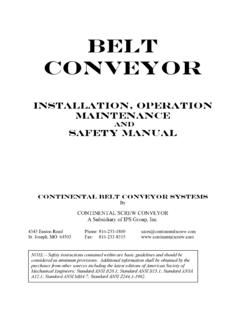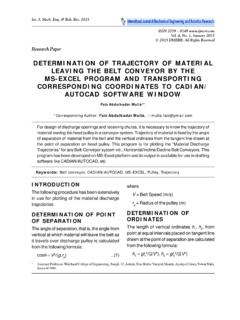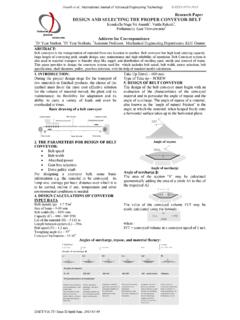Transcription of BUCKET ELEVATOR MANUAL
1 BUCKET ELEVATOR MANUAL Installation / Operation / Maintenance CONTINENTAL SCREW conveyor A Subsidiary of IPS Group, Inc. 4343 Easton Road Phone: 816-233-1800 St. Joseph, MO 64503 Fax: 816-233-8315 NOTE Safety instructions contained within are basic guidelines and should be considered as minimum provisions. Additional information shall be obtained by the purchaser from other sources including the latest editions of American Society of Mechanical Engineers; Standard ANSI ; Standard ANSI ; Standard ANSA ; Standard ANSI ; Standard ANSI TABLE OF CONTENTS CONSTRUCTION.
2 1 INSTALLATION.. 1 BELT SPLICING AND BUCKET MOUNTING.. 3 ILLUSTRATIONS OF BELT SPLICES.. 4 ILLUSTRATIONS OF BUCKET ATTACHMENTS.. 5 OPERATION.. 8 ELEVATOR CAPACITY.. 9 MAINTENANCE.. 10 LUBRICATION.. 10 CONTINENTAL SCREW conveyor Page 1 BUCKET ELEVATOR MANUAL BUCKET ELEVATORS FOUNDATION Because most BUCKET elevators are self-supporting for vertical loads, the foundation must be designed to take the total weight of the ELEVATOR and the material that is to be lifted by the BUCKET ELEVATOR .
3 The foundation must be level to provide the proper support for the ELEVATOR and the casing must be braced for wind loads at intervals shown on the drawings. CASING COUNSTRUCTION BUCKET elevators are furnished with three types of construction. Please refer to your general arrangement drawing for the type of construction used on your ELEVATOR . The following is the list of types of construction and how the filed connection joints must be made for each type. 1. STANDARD CONSTRUCTION 2 on 20 centers welds for inside casing joints, outside of casing sheets will be skip welded 2 on 12 centers to angles.
4 No gaskets or caulking will be provided for any joints. 2. DUST TIGHT CONSTRUCTION 2 on 20 centers welds for casing inside joints, outside casing sheets will be skip welded 2 on 12 centers to angles. Inside joints will be caulked with compound between welds to seal joints. Gaskets will be provided at all bolted joints. 3. WEATHER TIGHT CONSTRUCTION All inside casing joints will be welded continuously, outside of casing sheets will be skip welded 2 on 12 centers to angles. Gaskets will be provided at all bolted joints.
5 INSTALLATION OF BUCKET ELEVATORS ASSEMBLING CASING 1. A BUCKET ELEVATOR is actually a belt and pulley transmission enclosed within a casing. 2. For proper operation care must be taken to maintain belt and shaft alignment. 3. Although alignment is checked by the manufacturer prior to shipment, correct and proper care must be maintained during erection to assure a straight and plumb casing from head to boot section, as a twist or leaning casing would prevent proper tracking of belt on pulleys. 4. BUCKET elevators are comprised of three main assemblies: head terminal, boot terminal, and intermediate assemblies and components.
6 All terminals are factory assembled and shipped assembled. All intermediate casings are shipped in individual pieces. CONTINENTAL SCREW conveyor Page 2 BUCKET ELEVATOR MANUAL 5. Assemble casing first by setting boot section and ten to twenty feet of intermediate leg casing. Use a plumb line from top to bottom to check vertical and level setting of boot on base, using shims if necessary near anchor bolt holes (not at corners). Grout under boot after ELEVATOR is completely assembled. 6. Assemble remaining intermediate leg sections respectively as marked by the manufacturer.
7 Usually the boot will be marked A , then the first leg section B , second, C , etc. These markings will be located in the lower right corner of each section and after assembly can be readily checked by sight from bottom to top. TAKE-UPS Take-ups, a mechanical device for adjusting shaft center distances should be provided for all elevators to compensate for elongation as wear occurs and to provide temporary slack for installation or maintenance work. Wherever possible, take-ups on elevators should be mounted at the foot end.
8 This eliminates the troublesome adjustment of the drives as would be the case if the take-up were mounted on the head end. For elevators, caution must be used when adjusting take-ups to prevent statically over-stressing belt and terminal equipment. A proper amount of slack should be allowed to obtain smooth belt travel motion. On all belt elevators the adjustment should be made while the ELEVATOR is in operation to insure the adjustment which will meet the above conditions. SHAFT AND PULLEY ALIGNMENT Proper alignment of the pulley and shaft greatly lengthens belt life.
9 To assure correct alignment, the following steps are necessary: 1. Carefully level the shafts. Use a machinist s level directly on the shaft. 2. Align the shaft for parallelism, using a line for long centers. Recheck the level adjustment. Tighten all securing bolts and nuts to assure maintenance of shaft alignment. 3. Align the pulley axially on the shafts. A plumb bob should be used to check the alignments to head and foot pulleys and shafting after leveling shafts. CONTINENTAL SCREW conveyor Page 3 BUCKET ELEVATOR MANUAL INSTALLING BELT In the installation of ELEVATOR belts, certain general practices should be followed.
10 The first is to be sure you select the best type of belt for the service to be performed. Consult your belt catalog or call your nearest belt distributor to check your selection. Install the ELEVATOR belt with foot take-ups positioned at upper end of travel, and head end take-ups at lower end of travel to provide maximum adjustment. 1. Where it is possible to lower belt from the top of the ELEVATOR casing, the following method can be applied: Make lifting hitch off center, to make one leg long enough to go around the foot pulley and up to the inspection door.







